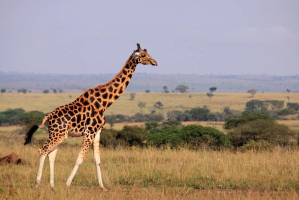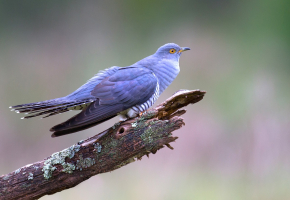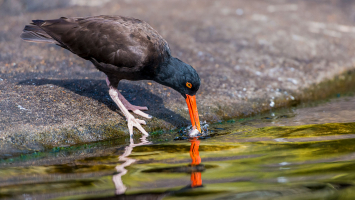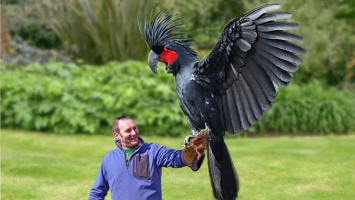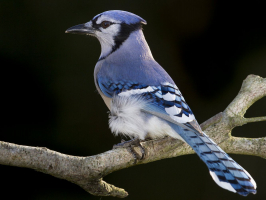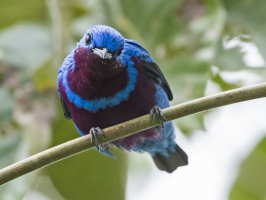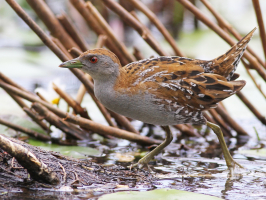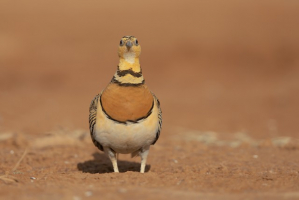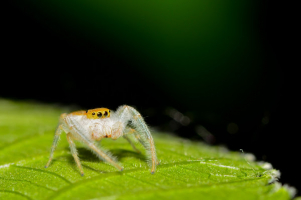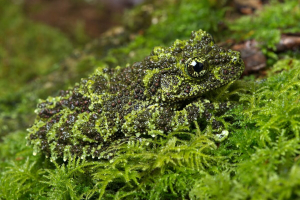Top 10 Most Amazing Birds with Long Tails
The birds look great and even greater with elegant and colorful feathers. Apart from keeping the bodies warm, the feathers on the wings and tails play a ... read more...crucial role in making their bodies aerodynamic. The tail feathers help them to navigate through the air. But not all birds use a tail feather for navigation only. Some have elegant tail feathers as adornments that they use for courtship to attract mates with eye-catching length and color. Below is a list of the most amazing birds with long tails, let's find out!
-
The Long-Tailed Widowbird (Euplectes progne), also known as the "Sakabula", is a species of bird in the family Ploceidae. The species are found in Angola, Botswana, the DRCongo, Kenya, Lesotho, South Africa, Eswatini, and Zambia. The medium-sized long-tailed widowbird is one of the most prevalent birds in the areas it calls home. Adult breeding males have nearly all-black bodies, shoulders (epaulets) of orange and white, long, wide tails, and bluish-white bills. Females are relatively unremarkable, with thin tail feathers, beaks that are the color of horn, and feathers that are striped tawny and black with light patches on the chest, breast, and back.
Male long-tailed widowbirds can be easily identified in flight thanks to their incredibly long tails. They have twelve tail feathers, six to eight of which are between six and eight centimeters (20 inches) long. The male flies with modest wingbeats 0.5 to 2 meters (20 to 78 inches) above his area while the tail is stretched vertically into a deep, long keel below him.
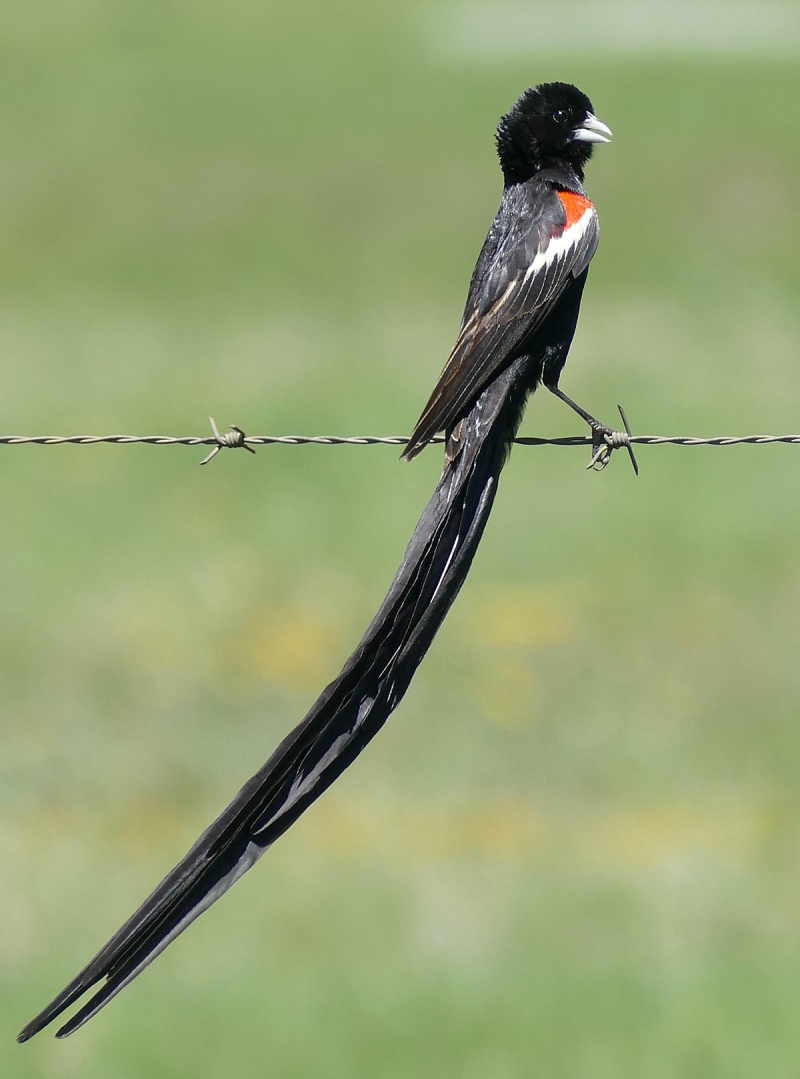
Wikipedia 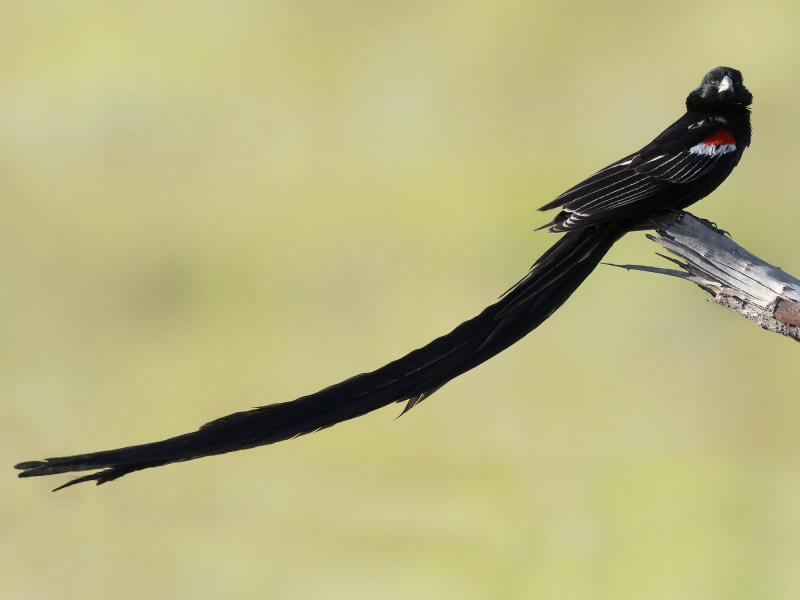
eBird -
The Ribbon-Tailed Astrapia, also known as Shaw Mayer's astrapia (Astrapia mayeri), is a species of bird-of-paradise. In the western portion of the central highlands of Papua New Guinea, subalpine woods are home to the ribbon-tailed astrapia, which is widespread and unique there. The male is polygamous, like many other decorative birds of paradise. It is the bird of paradise that has most recently been found.
The medium-sized ribbon-tailed astrapia can reach a length of 32 cm (without including the tail of the male, which can be over 1 metre). The male ribbon-tailed astrapia, one of the most impressive birds of paradise, has the longest tail feathers relative to the body size of any bird, measuring more than three times the length of its body. In general, male ribbon-tailed astrapia are about 125 cm long, while females are about 35 cm. The male has two incredibly long, ribbon-like white tail feathers, an ornate "ball" plume above its bill, and an iridescent olive green and bronze body. The female's body is a considerably duller shade of brown and black, and her head is iridescent. Females lack the long white tails that are present in males.
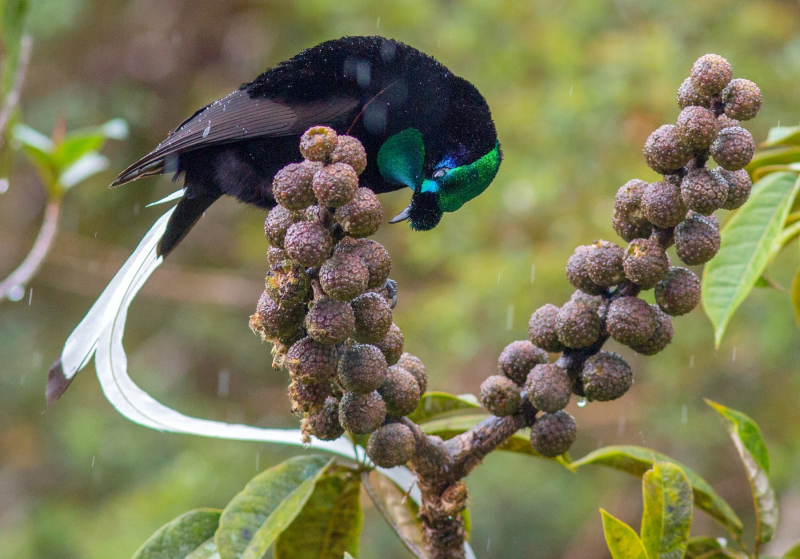
eBird 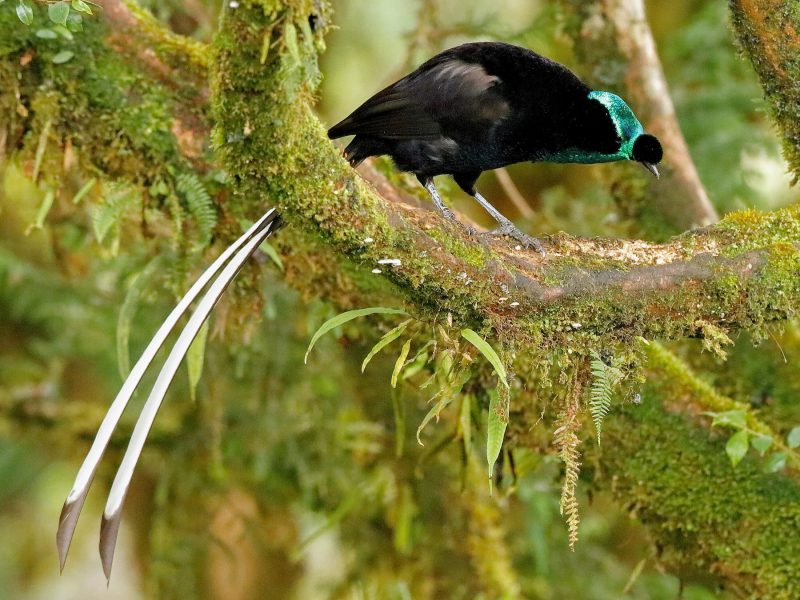
eBird -
The Indian Paradise Flycatcher (Terpsiphone paradisi) is a medium-sized passerine bird native to Asia, where it is widely distributed. As the global population is considered stable, it has been listed as Least Concern on the IUCN Red List since 2004. It is native to the Indian subcontinent as well as Central Asia and Myanmar.
Indian paradise flycatcher adults have a length of 19–22 cm. They have glossy black heads with a black crown and crest, a big, robust black bill, and black eyes. Females have a rufous back and underparts and a grayish neck. They have 86–92 mm-long wings. Young boys resemble females almost exactly, but they have black necks and eyes with blue rings. As adults, they produce two primary tail feathers that can reach lengths of up to 30 cm each, resulting in streamers that can be up to 24 cm long. Young males have short tails and are rufous in color. In the second or third year, they grow long tails. Male adults have either a brilliant rufous coloration on top or are mostly white. Some specimens have a degree of intermediate rufous-to-white coloration. The shaft streaks on the wing and tail feathers of long-tailed rufous birds are typically absent, whereas in white birds, the shaft streaks, and occasionally the edges of the wing and tail feathers, are black.
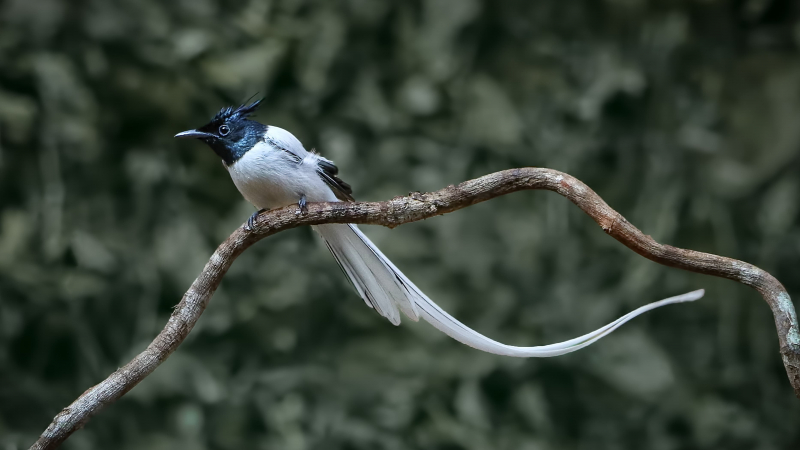
CGTN 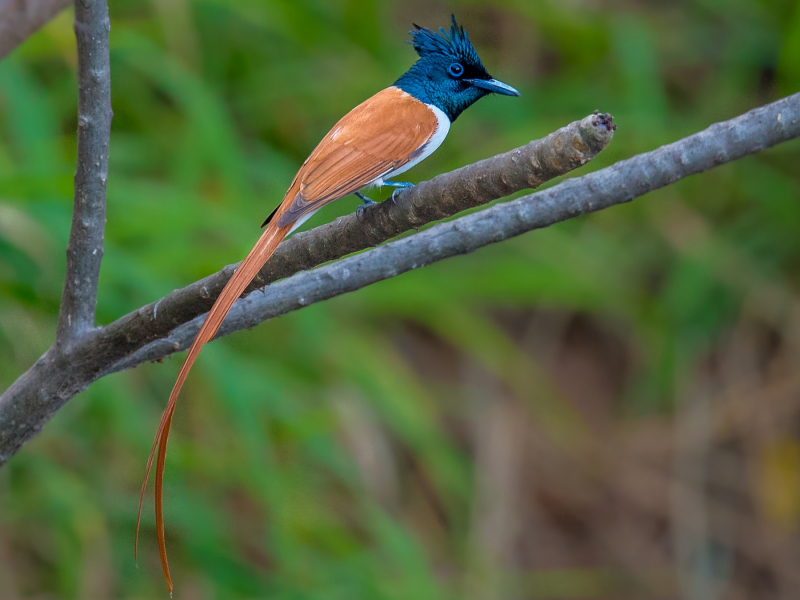
eBird -
Golden Pheasants are renowned for having brilliantly colored feathers. They have a stunning red-tipped golden-yellow crest. Their face and underparts are a vivid crimson color. Rusty tan covers the sides and throat. The upper back and wattle are green and yellow, respectively. They also have a long, pale brown tail and dark, red shoulder feathers.
Golden pheasants' males are brighter than their female counterparts. Their flanks and breast are a recognizable scarlet color. They also feature remarkable black patches in the center of their tail feathers. Female pheasants have duller, more mottled brown plumage than do males. In Western and Central China, there are many deep forests and woodlands where golden pheasants can be found. Longer male golden pheasants than females. A mature guy typically measures up to 42 inches in length. It's interesting to note that the tail makes up two-thirds of the body's length. They mostly eat berries, seeds, and insects for food.
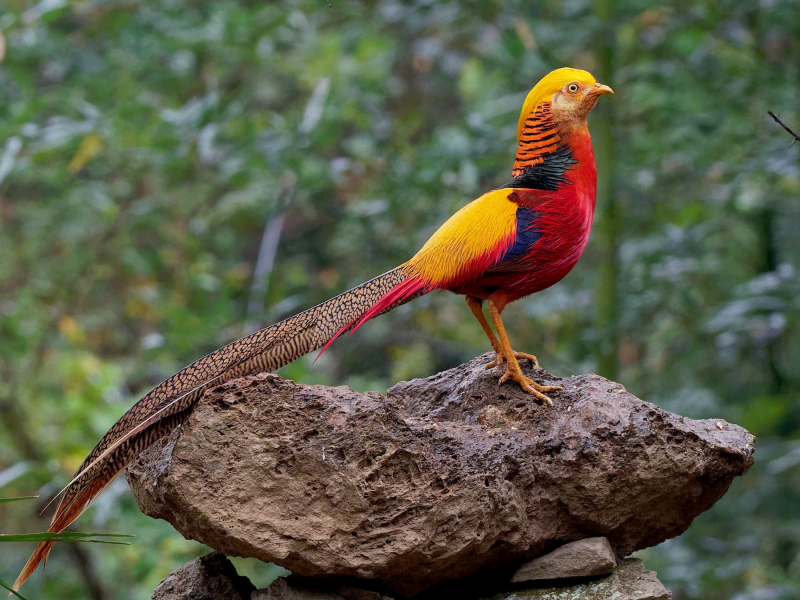
eBird 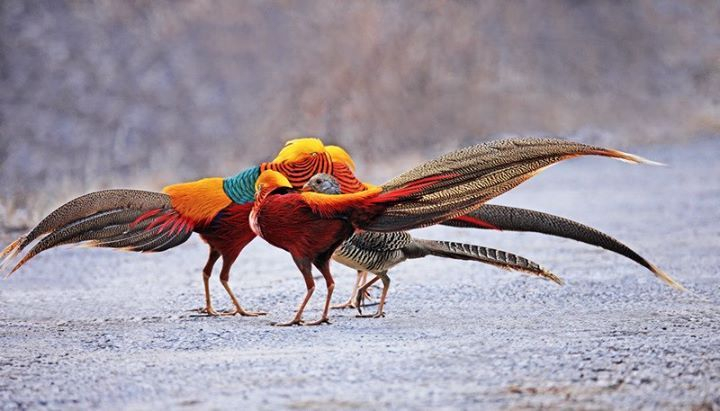
Wikipedia -
The White-Tailed Tropicbird (Phaethon lepturus) is a tropicbird. It is the smallest of three closely related seabirds of the tropical oceans and the smallest member of the order Phaethontiformes. The tropical Atlantic, western Pacific, and Indian Oceans are where you can find them. Along with some other Caribbean islands, it breeds there as well. Recently, a few pairs have begun building nests on Little Tobago to join the red-billed tropicbird colony. The term "longtail" is used locally in Bermuda, where it nests outside of the tropical Atlantic.
The adult white-tailed tropicbird is a slender, mainly white bird, 71–80 cm long including the very long central tail feathers, which double its total length. 89-96 cm is the wingspan. The bird has an orange-yellow to the orange-red bill, a black band on the inner wing, and a black eye mask. Sexes are similar, although males on average are longer tailed, but juveniles lack the tail streamers, have a green-yellow bill, and a finely barred back. The white-tailed tropicbird does not have an annual breeding cycle; rather, the frequency of breeding is influenced by the weather and the accessibility of good breeding grounds. The bird can breed either 10 months or 5 months after the most recent successful breeding.
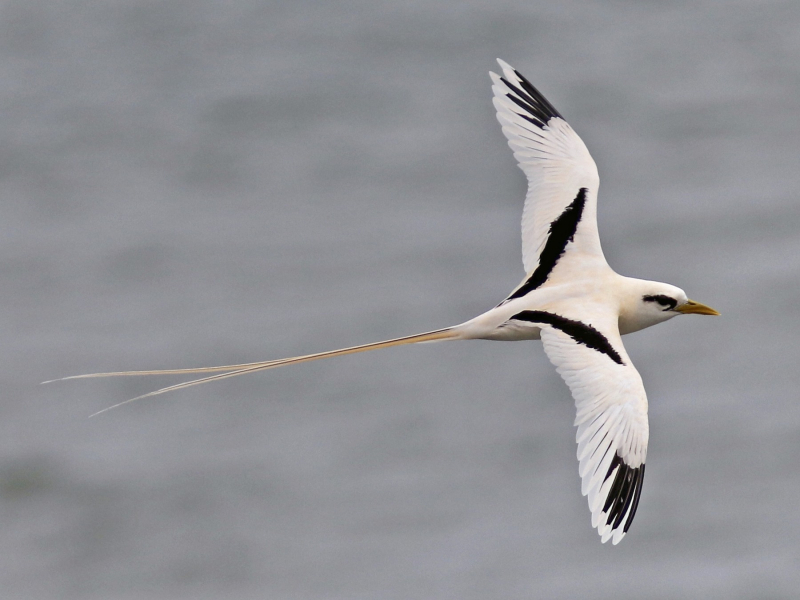
eBird 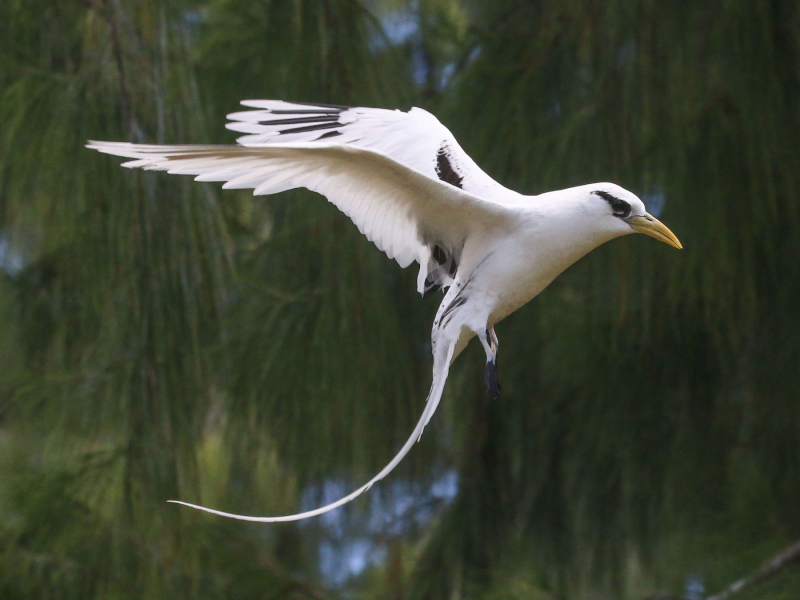
eBird -
The Superb Lyrebird (Menura novaehollandiae) is an Australian songbird, one of two species from the family Menuridae. It is one of the biggest songbirds in the world and is well known for its complex courtship and tail displays as well as its superb mimicry. The species is indigenous to Australia and can be found in southeast Australian forests. According to David Attenborough, the magnificent lyrebird exhibits the animal kingdom's most advanced vocal abilities - "the most elaborate, the most complex, and the most beautiful".
It is well known that lyrebirds have elaborate tails. Male adults have tails that can measure up to 70 cm in length and contain sixteen feathers. The outer two feathers, known as the lyrates, are broad S-shaped, and have brown and buff coloring. They were originally given this name because they resembled a lyre. Twelve filamentaries, feathers with malleable silvery barbs, are located between the lyrates. Two silvery median feathers may be seen in the middle of the tail. With shorter lyrates and plain, wide feathers in place of the filamentary, the female's tail is less ornamented. Juveniles of both sexes lack decorative tail feathers. Through a series of annual molts, the structure and patterning of the feathers change to become the mature bird's tail plumage.
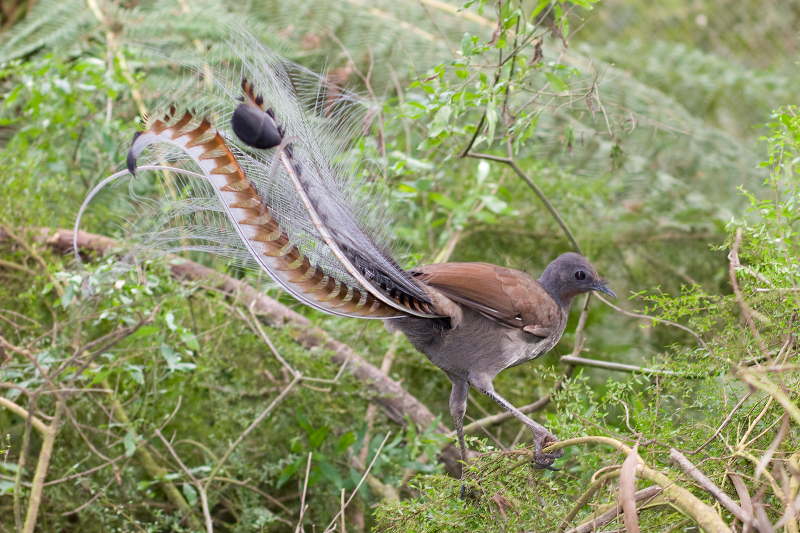
Wikipedia 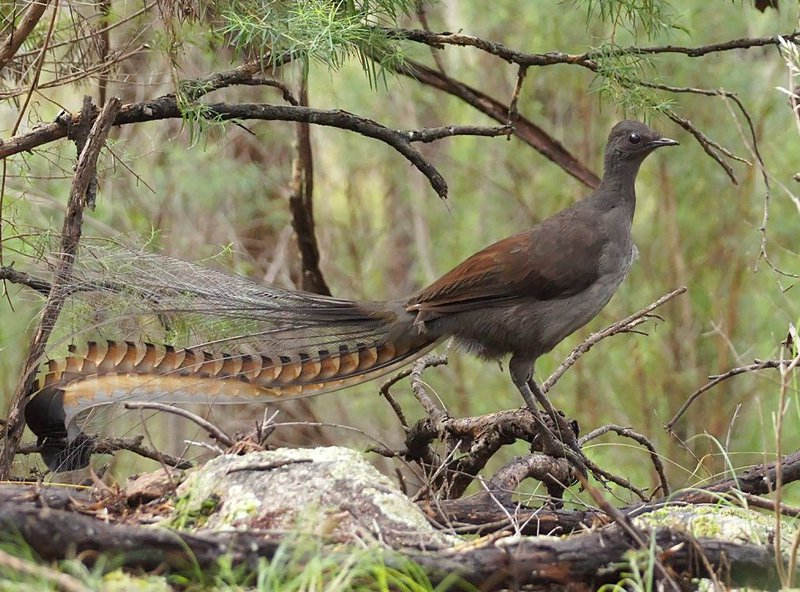
Australian Museum -
Lady Amherst's Pheasant (Chrysolophus amherstiae) is a bird of the order Galliformes and the family Phasianidae. The genus name is from Ancient Greek khrusolophos, "with golden crest". Sarah Amherst, who was in charge of delivering the first specimen of the bird to London in 1828, is honored with the English name and amherstiae. The IUCN Red List of Threatened Species rates Lady Amherst's pheasant as Least Concern.
The tail makes up 80 cm of the mature male's total length, which ranges from 100 to 120 cm. It is easily recognized by its nuchal cape, which is white, black, and has a crimson crest. Red, blue, dark green, white, and yellow feathers cover the long, grey tail and the rump. The "cape" can be displayed by being elevated. The golden pheasant (C. pictus), to which this species is closely related, has blue-green exposed skin around its eyes and a yellow eye. They had blue-gray legs and a bill that looked like a horn. The female is much less showy, with a duller mottled brown plumage all over, similar to that of the female common pheasant (P. colchicus) but with finer barring. She is very like the female golden pheasant but has a darker head and cleaner underparts than the hen of that species.
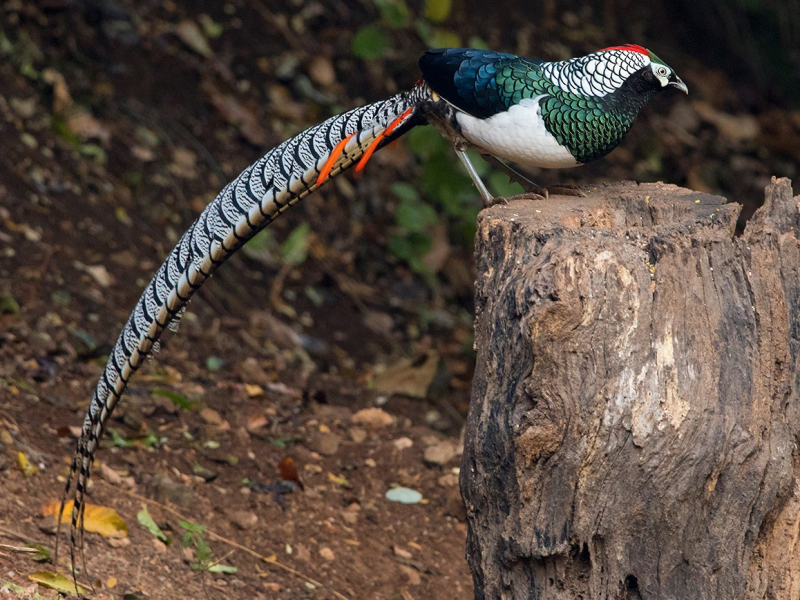
eBird 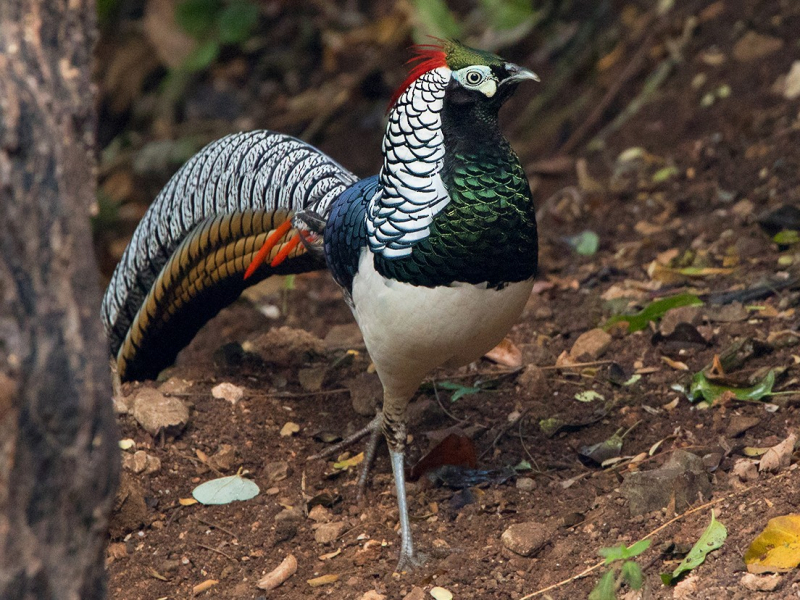
eBird -
The Resplendent Quetzal (Pharomachrus mocinno) is a small bird found in southern Mexico and Central America, with two recognized subspecies, P. m. mocinno and P. m. costaricensis. These creatures are members of the Trogonidae family and are found in tropical woods, notably montane cloud forests. The dazzling quetzal is an omnivore like other quetzals; it primarily consumes fruits from the Lauraceae family, but it also occasionally eats insects, lizards, frogs, and snails.
The resplendent quetzal is the largest trogon. The tail streamers of the nominate subspecies range in length from 31 cm to 100.5 cm, with the median length for males being 75 cm. It is 36 to 40 cm long. The costaricensis subspecies is slightly smaller than the nominate subspecies and has shorter wings and bills than the nominate subspecies, which weighs about 210 g. The median length of the tail plumes, which range in length from 63 cm to 86 cm, is shorter and slimmer. While females are duller and have shorter tails, males have iridescent green plumes, a red lower breast and belly, black inner wings, and a white undertail. Females are distinguished by having bronze-green heads, grey lower breasts, bellies, and bills.
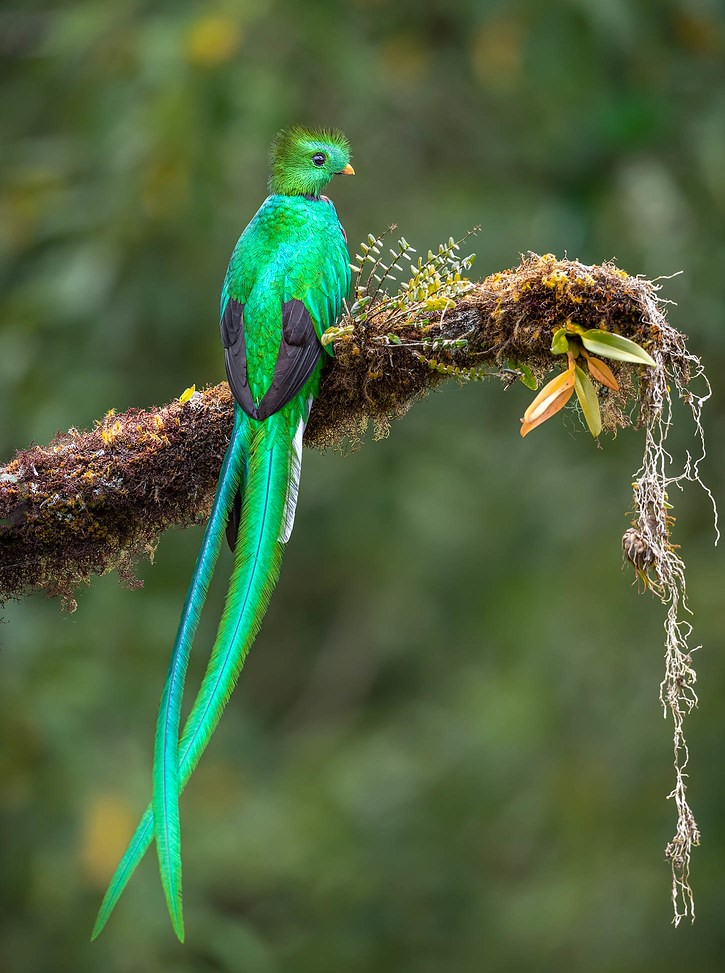
eBird 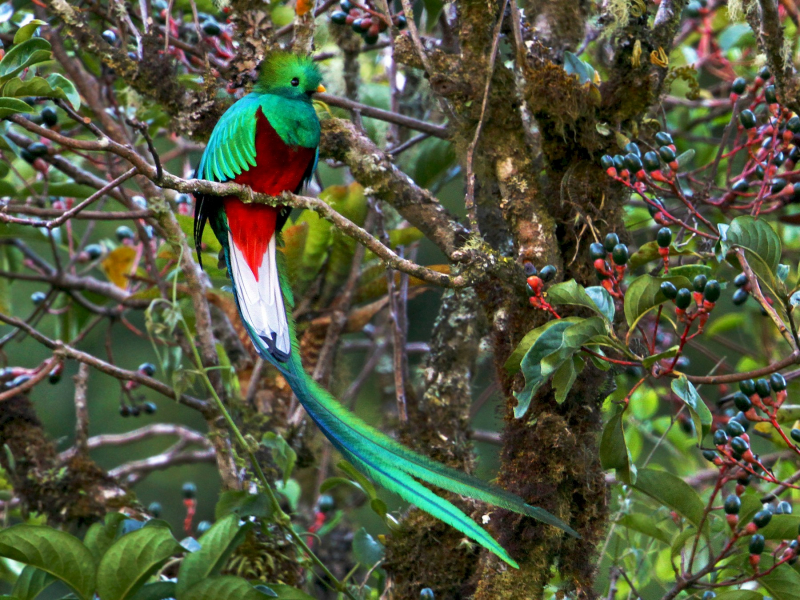
eBird -
The Fork-Tailed Flycatcher (Tyrannus savana) is a passerine bird of the tyrant flycatcher family and is a member of a genus typically referred to as kingbirds. Fork-tailed flycatchers are found in places with light forest or grassland cover from southern Mexico to as far south as Argentina. They get their name from their distinctively long, forked tail. The majority of the time, they are seen sitting on prominent perches waiting for flying arthropods to fly by before sauntering out to catch their prey and heading back to their perches. While fork-tailed flycatchers that live further south are migrants with a reputation for wandering as far north as the Eastern Seaboard of the United States, northern populations close to southern Mexico appear to be permanent inhabitants.
The fork-tailed flycatcher has a black head and is white underneath and gray above. Sometimes, males exhibit a yellow head stripe. Additionally, males have a very long, forked tail that is even longer than that of the closely related scissor-tailed flycatcher. The tail is slightly shorter in females and much shorter in juveniles. Including the tail, males are 37–41 cm in length, while females measure 28–30 cm. They are substantially lighter than closely related kingbirds, which are twice as long as this species' entire length, weighing only 28–32 g. In comparison to the length of the bird from the base of the tail to the bill, the mature male's tail is two to three times longer. Generally, males and females of the species look quite similar but can be distinguished by the longer tail in males.
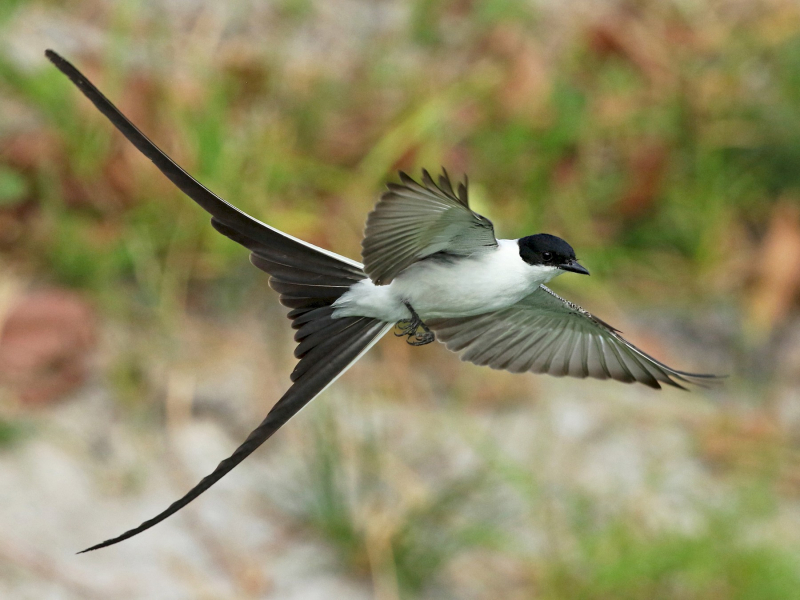
eBird 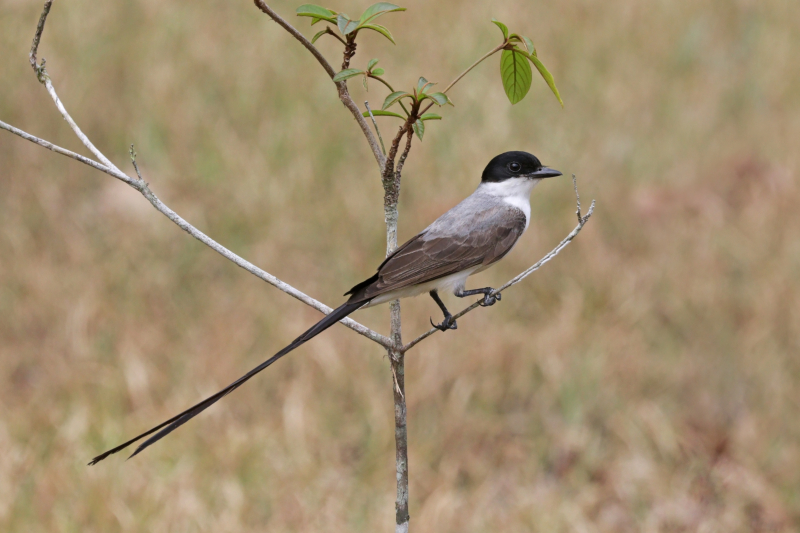
Wikipedia -
The Greater Bird-Of-Paradise (Paradisaea apoda) is a bird-of-paradise in the genus Paradisaea. Carl Linnaeus named the species Paradisaea apoda, or "legless bird-of-paradise" because early trade-skins to reach Europe were prepared without wings or feet by the indigenous New Guinean people; This resulted in the misconception that these birds were lovely visitors from paradise who were kept aloft by their plumes and never touched the earth until they died.
The largest member of the Paradisaea genus and the bird with the most opulent display is the bigger bird-of-paradise. Males can reach a height of 43 cm (excluding the long twin tail wires). At 48 cm, the female is larger. This species' feathers exhibit sexual dimorphism as well. The male's face is iridescent green, and his crown, skull, and nape are glazed with silver iridescence. The body's remaining feathers are maroon-brown. The flank plumes, which are employed in displays, start out yellow at the base before turning white and having maroon streaks. The female has maroon-brown feathers that are unbarred. The iris and bills are both yellow in both sexes.
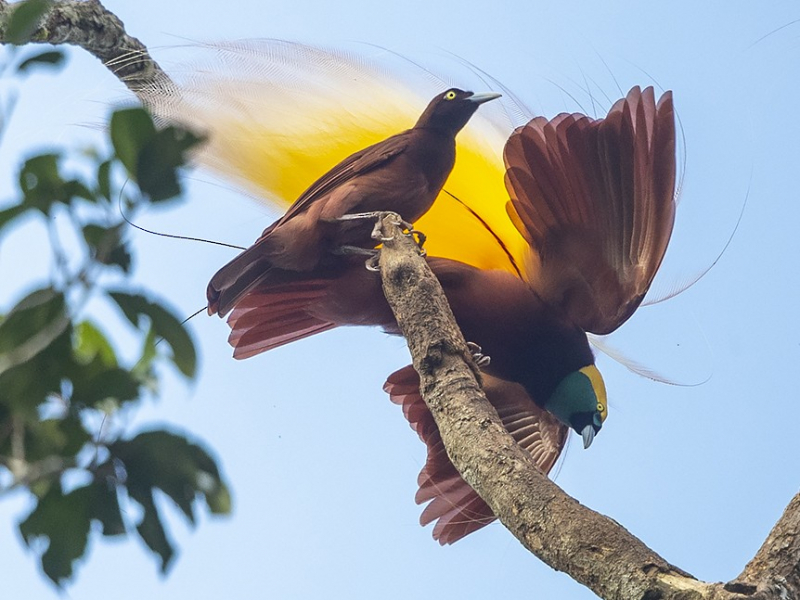
Pinterest 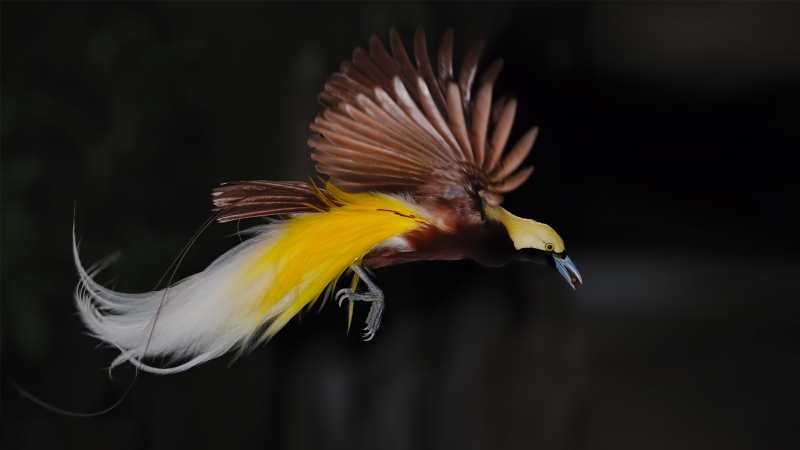
eBird












